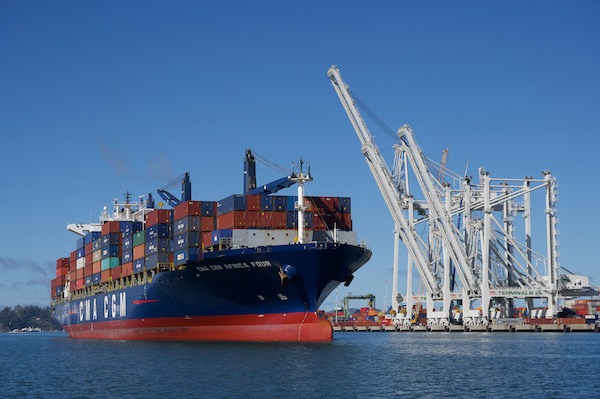Southern California ports have been seeing congestion in the past months, and this is now also affecting other ports. Specifically, the Port of Oakland, located in the San Francisco Bay, has been seeing a decline in their cargo volume in January, as a result of the spreading supply chain congestion. Andrew Hwang, Manager of Business Development and International Marketing, Maritime Division for the Port of Oakland shares: “We won’t have the February figures until mid-March, but our sense is that once the logjam in Southern California begins to ease, then more ships will be released. As that happens, those vessels scheduled for Oakland will set sail for our seaport here in Northern California and boost the number of ships calling in Oakland.”

CMA CGM first-call Golden Gate Bridge service at Oakland International Container Terminal. Photo courtesy: CMA CGM.
Congestion in Southern California
The congestion in Southern California ports has been going on since the end of November of last year. “The surge in e-commerce, which has increased the volume of import cargo into the U.S., is a key factor causing the congestions,” says Hwang.
The congestion is causing a rise in the number of ships that are arriving late to the Port of Oakland, which is often their next stop. “This impacts our operations here, because it disrupts the normal schedule to work the vessels,” Hwang says. When the ships arrive late, they often miss their berthing appointments, causing them to have to anchor and await berth space.
Fortunately, the Port of Oakland is working hard to ensure that the shelf-life of perishable products isn’t affected by these challenges. “Oakland is the preferred export terminal for California produce due to the preponderance of last port of call services at the Port of Oakland. Perishables are loaded as close to the vessel cut as possible because once the product is harvested, the clock starts on its shelf-life. There is no logistics process that can stop the decay process, so all parties in the supply chain work very hard to keep perishables moving to their final destination in a timely manner,” Hwang explains.
Oakland becomes a preferred first-call port
Due in part to the delays in the Southern California ports, shipping line CMA CGM introduced a first-call service in Oakland, and other ocean carriers are contemplating Oakland first-calls by mid-year. Hwang shares: “The ships in CMA CGM’s weekly service now make Oakland their first US call, bypassing Southern California. This is their new Golden Gate Bridge service, which made its first North America stop at the Port of Oakland on February 12th, 2021, connecting the Shanghai Yantian and Kaohsiung ports to Oakland.”
Ed Aldridge, President of CMA CGM America, says: “CMA CGM is the first and only trans-pacific carrier to offer a direct service from Asia to Oakland, California. Our recently launched Golden Gate Bridge service is a testament to CMA CGM’s ongoing resilience, agility and customer responsiveness. We are very proud to be able to support customers located in the San Francisco Bay Area, as well as those importers and exporters located across the United States, who will now use this gateway via rail, to increase their speed to market, and bring improved consistency and reliability to their supply chain.”
New crane installations
Another factor contributing to the cargo declines at the Port of Oakland is the temporary loss of berth capacity at Oakland’s largest marine terminal, where new cranes are being assembled. “New ship-to-shore (STS) cranes, the tallest in North America, are being assembled there. We estimate that this berth will become available again sometime this spring. The three new cranes, once installed, will easily handle the biggest containerships calling the US,” Hwang concludes.
For more information:
Marilyn Sandifur
Port of Oakland
Tel: +1 (510) 627-1193
Email: msandifur@portoakland.com
www.portofoakland.com
